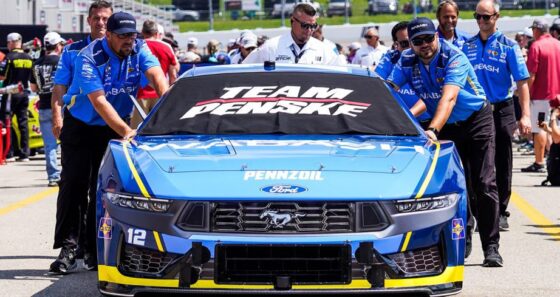In early 2025, NASCAR fans got a big surprise. Someone visiting Team Penske’s race shop spotted an electric car parked between Joey Logano and Austin Cindric’s Cup cars. It didn’t make a sound, but it made a lot of noise online. It seems that Ford, one of NASCAR’s longest-serving manufacturer partners, is heading towards a transformative new chapter in its racing and production future. Now the question is: Is NASCAR really going electric?
Roger Penske himself has been candid about his vision for NASCAR’s future, openly endorsing a hybrid formula as a practical middle ground toward full electrification. While he acknowledges the current technological and infrastructural limitations of all-electric race cars, Penske sees hybrid powertrains as a crucial step in balancing innovation with the sport’s heritage.
While Ford races into the electric future, Chevy and Dodge are sticking to what made them iconic. Chevy is keeping the Camaro in NASCAR even after ending its production, holding onto its muscle car legacy. Dodge is making a comeback in 2026 through the Truck Series, bringing back its classic racing roots.
Ford to invest billions in its ‘Next Model T Moment’
Ford has recently announced, as per Adam Stern on X, that it will pour a staggering $5 billion into U.S. electric vehicle production. A news that is being hailed as the company’s “next Model T moment.” Doug Field, Ford’s chief EV digital and design officer, dropped this powerful line, drawing a direct parallel to Ford’s revolutionary launch of the Model T over a century ago.
Back in 1908, the Model T transformed the automobile from a luxury item into an affordable necessity, reshaping the entire transportation industry and American society. Now, Ford is betting that its new generation of electric vehicles, with cutting-edge battery tech and streamlined production lines, will do the same for the EV era, making electric cars accessible and mainstream, just like the Model T did for gas-powered cars. This isn’t just business as usual; it’s a full-on revolution aimed at reshaping how Americans drive, and potentially how motorsports like NASCAR evolve too.
“Ford plans to invest billions in new electric vehicle production, calling it the company’s ‘next Model T moment.’ Ford said Monday it will invest $5 billion into a new assembly line and battery production to build EVs.” – @CNN https://t.co/yHtCx8flIx
— Adam Stern (@A_S12) August 11, 2025
At the core of Ford’s ambitious plan is a radical redesign of its assembly line, moving away from the traditional straight-line setup pioneered by Henry Ford himself in 1913. The new “tree layout,” as Ford describes it, is designed to feed vehicle parts into each other in multiple streams, speeding up production while reducing costs and physical strain on workers.
This efficiency boost will be essential as Ford shifts from producing gas-powered SUVs like the Escape to their all-electric counterparts, including an upcoming, yet-to-be-named electric pickup truck expected to be the most affordable in its class, priced around $30,000. However, this transition also comes with challenges, including the loss of roughly 600 jobs at the Louisville plant due to increased automation and efficiency, a stark reminder that the electric revolution, while promising, also disrupts established systems.
What does all this mean for NASCAR? With Ford’s aggressive EV push and NASCAR’s own debut of an all-electric prototype at the 2024 Chicago Street Race, it’s clear the sport cannot afford to ignore the electric future. Although not yet a competitive race entry, the prototype embodies NASCAR’s willingness to experiment with advanced technologies, positioning the sport on the cusp of a significant transformation.
While Ford’s electric ambitions may be reshaping the horizon, its legacy in NASCAR continues to thrive in the here and now. Ryan Blaney’s performance at The Glen was a reminder that speed, strategy and grit still define the sport.
Blaney leads the way for Team Penske at the Glen
Team Penske made its presence felt at Watkins Glen in 2025, with Ryan Blaney leading the charge. Blaney set the tone by earning the pole position his first at The Glen and the 150th Cup Series pole for Team Penske after narrowly edging out road course ace Shane van Gisbergen. Starting from the front, Blaney held his own against some of the sport’s most formidable road racers, securing a Stage 2 victory and keeping the No. 12 Ford in contention throughout the afternoon. Despite a tight-handling car in the closing laps, he crossed the line in sixth on Sunday, marking another strong performance in his push toward the playoffs.
Blaney was candid about his road course craft, even after bypassing one of the series’ most dominant specialists for the top starting spot. “I’m pretty average road racer, honestly,” he admitted. “And I work really hard to try to get better at it and try to figure out ways to be better.” His run at the Glen reflected that commitment, blending improved pace with strategic execution. While teammates Joey Logano and Austin Cindric finished 14th and 16th respectively, Blaney’s pole win, stage victory, and top-10 finish highlighted the team’s competitive edge on one of the season’s most challenging circuits.
The post NASCAR Manufacturer Doubles Down on EVs as Chevy & Dodge Go Back to Their Roots appeared first on EssentiallySports.
